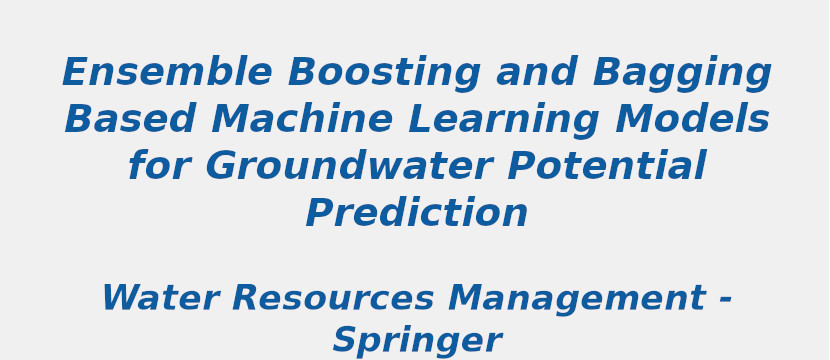Research Area: Machine Learning
Due to the rapidly increasing demand for groundwater, as one of the principal freshwater resources, there is an urge to advance novel prediction systems to more accurately estimate the groundwater potential for an informed groundwater resource management. Ensemble machine learning methods are generally reported to produce more accurate results. However, proposing the novel ensemble models along with running comparative studies for performance evaluation of these models would be equally essential to precisely identify the suitable methods. Thus, the current study is designed to provide knowledge on the performance of the four ensemble models i.e., Boosted generalized additive model (GamBoost), adaptive Boosting classification trees (AdaBoost), Bagged classification and regression trees (Bagged CART), and random forest (RF). To build the models, 339 groundwater resources’ locations and the spatial groundwater potential conditioning factors were used. Thereafter, the recursive feature elimination (RFE) method was applied to identify the key features. The RFE specified that the best number of features for groundwater potential modeling was 12 variables among 15 (with a mean Accuracy of about 0.84). The modeling results indicated that the Bagging models (i.e., RF and Bagged CART) had a higher performance than the Boosting models (i.e., AdaBoost and GamBoost). Overall, the RF model outperformed the other models (with accuracy = 0.86, Kappa = 0.67, Precision = 0.85, and Recall = 0.91). Also, the topographic position index’s predictive variables, valley depth, drainage density, elevation, and distance from stream had the highest contribution in the modeling process. Groundwater potential maps predicted in this study can help water resources managers and policymakers in the fields of watershed and aquifer management to preserve an optimal exploit from this important freshwater.
Keywords:
Groundwater potential prediction
Ensemble machine learning models
Decision tree
Boosting
Bagging
Recursive feature elimination
Author(s) Name: Amirhosein Mosavi, Farzaneh Sajedi Hosseini, Bahram Choubin, Massoud Goodarzi, Adrienn A. Dineva & Elham Rafiei Sardooi
Journal name: Water Resources Management
Conferrence name:
Publisher name: Springer
DOI: 10.1007/s11269-020-02704-3
Volume Information: 35, pages 23–37 (2021)
